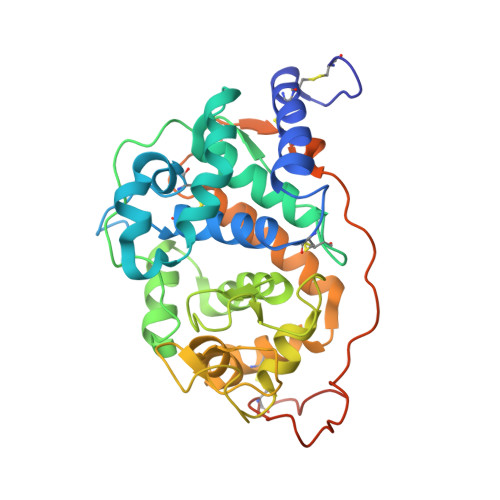Improving the Ph-Stability of Versatile Peroxidase by Comparative Structural Analysis with a Naturally-Stable Manganese Peroxidase.
Saez-Jimenez, V., Fernendez-Fueyo, E., Medrano, F.J., Romero, A., Martinez, A.T., Ruiz-Duenas, F.J.(2015) PLoS One 10: 40984
- PubMed: 26496708
- DOI: https://doi.org/10.1371/journal.pone.0140984
- Primary Citation of Related Structures:
5ABN, 5ABO, 5ABQ - PubMed Abstract:
Versatile peroxidase (VP) from the white-rot fungus Pleurotus eryngii is a high redox potential peroxidase of biotechnological interest able to oxidize a wide range of recalcitrant substrates including lignin, phenolic and non-phenolic aromatic compounds and dyes. However, the relatively low stability towards pH of this and other fungal peroxidases is a drawback for their industrial application. A strategy based on the comparative analysis of the crystal structures of VP and the highly pH-stable manganese peroxidase (MnP4) from Pleurotus ostreatus was followed to improve the VP pH stability. Several interactions, including hydrogen bonds and salt bridges, and charged residues exposed to the solvent were identified as putatively contributing to the pH stability of MnP4. The eight amino acid residues responsible for these interactions and seven surface basic residues were introduced into VP by directed mutagenesis. Furthermore, two cysteines were also included to explore the effect of an extra disulfide bond stabilizing the distal Ca2+ region. Three of the four designed variants were crystallized and new interactions were confirmed, being correlated with the observed improvement in pH stability. The extra hydrogen bonds and salt bridges stabilized the heme pocket at acidic and neutral pH as revealed by UV-visible spectroscopy. They led to a VP variant that retained a significant percentage of the initial activity at both pH 3.5 (61% after 24 h) and pH 7 (55% after 120 h) compared with the native enzyme, which was almost completely inactivated. The introduction of extra solvent-exposed basic residues and an additional disulfide bond into the above variant further improved the stability at acidic pH (85% residual activity at pH 3.5 after 24 h when introduced separately, and 64% at pH 3 when introduced together). The analysis of the results provides a rational explanation to the pH stability improvement achieved.
Organizational Affiliation:
Centro de Investigaciones Biológicas, CSIC, Madrid, Spain.
















